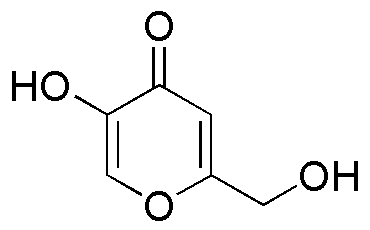Kojic acid is widely utilized in research focused on
- Cosmetics: Kojic acid is a popular ingredient in skin lightening products due to its ability to inhibit melanin production, helping to reduce dark spots and hyperpigmentation.
- Food Preservation: It serves as a natural preservative in food products, effectively preventing the growth of harmful bacteria and fungi, thus extending shelf life.
- Pharmaceuticals: In the pharmaceutical industry, it is used for its antioxidant properties, which can help in formulating products aimed at reducing oxidative stress in cells.
- Biotechnology: Researchers utilize kojic acid in various biochemical assays and experiments, particularly in studies related to enzyme inhibition and metabolic pathways.
- Agriculture: Kojic acid is being explored as a natural fungicide, providing an eco-friendly alternative to synthetic chemicals for protecting crops from fungal infections.
Informations générales
Propriétés
Sécurité et réglementation
Applications
Kojic acid is widely utilized in research focused on
- Cosmetics: Kojic acid is a popular ingredient in skin lightening products due to its ability to inhibit melanin production, helping to reduce dark spots and hyperpigmentation.
- Food Preservation: It serves as a natural preservative in food products, effectively preventing the growth of harmful bacteria and fungi, thus extending shelf life.
- Pharmaceuticals: In the pharmaceutical industry, it is used for its antioxidant properties, which can help in formulating products aimed at reducing oxidative stress in cells.
- Biotechnology: Researchers utilize kojic acid in various biochemical assays and experiments, particularly in studies related to enzyme inhibition and metabolic pathways.
- Agriculture: Kojic acid is being explored as a natural fungicide, providing an eco-friendly alternative to synthetic chemicals for protecting crops from fungal infections.
Documents
Fiches de données de sécurité (FDS)
La FDS fournit des informations de sécurité complètes sur la manipulation, le stockage et l’élimination du produit.
Spécifications du produit (PS)
Le PS fournit une description complète des propriétés du produit, notamment sa composition chimique, son état physique, sa pureté et les exigences de stockage. Il détaille également les plages de qualité acceptables et les applications prévues du produit.
Certificats d'analyse (COA)
Recherchez des certificats d'analyse (COA) en saisissant le numéro de lot du produit. Les numéros de lot et de lot se trouvent sur l'étiquette d'un produit, après les mots « Lot » ou « Lot de fabrication ».
Numéro de catalogue
Numéro de lot/série
Certificats d'origine (COO)
Ce certificat d'exploitation confirme le pays dans lequel le produit a été fabriqué, et détaille également les matériaux et composants utilisés et s'il est issu de sources naturelles, synthétiques ou autres sources spécifiques. Ce certificat peut être requis pour les douanes, le commerce et la conformité réglementaire.
Numéro de catalogue
Numéro de lot/série
Fiches de données de sécurité (FDS)
La FDS fournit des informations de sécurité complètes sur la manipulation, le stockage et l’élimination du produit.
DownloadSpécifications du produit (PS)
Le PS fournit une description complète des propriétés du produit, notamment sa composition chimique, son état physique, sa pureté et les exigences de stockage. Il détaille également les plages de qualité acceptables et les applications prévues du produit.
DownloadCertificats d'analyse (COA)
Recherchez des certificats d'analyse (COA) en saisissant le numéro de lot du produit. Les numéros de lot et de lot se trouvent sur l'étiquette d'un produit, après les mots « Lot » ou « Lot de fabrication ».
Numéro de catalogue
Numéro de lot/série
Certificats d'origine (COO)
Ce certificat d'exploitation confirme le pays dans lequel le produit a été fabriqué, et détaille également les matériaux et composants utilisés et s'il est issu de sources naturelles, synthétiques ou autres sources spécifiques. Ce certificat peut être requis pour les douanes, le commerce et la conformité réglementaire.


